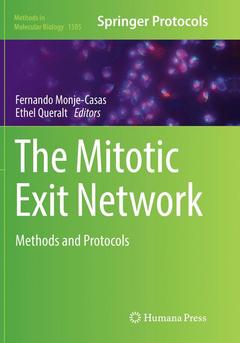The Mitotic Exit Network, 1st ed. 2017 Methods and Protocols Methods in Molecular Biology Series, Vol. 1505
Coordonnateurs : Monje-Casas Fernando, Queralt Ethel

Part I: Analysis of Cell Cycle Progression and Mitotic Exit
1. Regulation of Mitotic Exit in Saccharomyces cerevisiae
Bàrbara Baro, Ethel Queralt, and Fernando Monje-Casas
2. Methods of Synchronization of Yeast Cells for the Analysis of Cell Cycle Progression
M. Angeles Juanes
3. Analysis of Cell Cycle Progression in Saccharomyces cerevisiae Using the Budding Index and Tubulin Staining
Marta Muñoz-Barrera and Fernando Monje-Casas
4. Determination of Cell Cycle Stage and Mitotic Exit Through the Quantification of the Protein Levels of Known Mitotic Regulators
Cristina Cepeda-García
5. Cdc14 Localization as a Marker for Mitotic Exit: In Vivo Quantitative Analysis of Cdc14 Release
Gabriel Neurohr and Manuel Mendoza
Part II: Biochemistry of the MEN
6. In Vitro Analysis of Tem1 GTPase Activity and Regulation by the Bfa1/Bub2 GAP
Marco Geymonat, Adonis Spanos, and Katrin Rittinger
7. Analysis of Protein-Protein Interactions Between MEN Components
Rami Rahal
8. A New Methodology for the Quantification of In Vivo Cdc14 Phosphatase Activity
Ethel Queralt and José-Antonio Rodriguez-Rodriguez
9. Analysis of SUMOylation in the RENT Complex by Fusion to a SUMO-Specific Protease Domain
Neus Colomina, Clàudia Guasch, and Jordi Torres-Rosell
10. A Substrate Trapping Method for Identification of Direct Cdc14 Phosphatase Targets
Brendan L. Powers, Hana Hall, Harry Charbonneau, and Mark C. Hall
Part III: Analysis of the Localization of MEN Components
11. Localizing MEN Components by Indirect Immunofluorescence Analysis of Budding Yeast
Francesca Senic-Matuglia and Rosella Visintin
12. Analysis of the Localization of MEN Components by Live Cell Imaging Microscopy
Zhiang Guo and Marisa Segal
13. Evaluation of the Dynamicity of Mitotic Exit Network and Spindle Position Checkpoint Components on Spindle Pole Bodies by Fluorescence Recovery After Photobleaching (FRAP)
Ayse Koca Caydasi and Gislene Pereira
14. Asymmetric Localization of Components and Regulators of the Mitotic Exit Network at Spindle Pole Bodies
Ilaria Scarfone and Simonetta Piatti
15. Evaluation of the Nucleolar Localization of the RENT Complex to Ribosomal DNA by Chromatin Immunoprecipitation Assays
Julie Huang, Nahid Iglesias, and Danesh Moazed
Part IV: Control of Cellular Processes by the MEN
16. Analysis of the Functionality of the Mitotic Checkpoints
Roberta Fraschini
17. Cdc14 and Chromosome Condensation: Evaluation of the Recruitment of Condensin to Genomic Regions
Facundo Ramos, Joanne Leonard, Andrés Clemente-Blanco, and Luis Aragón
18. Studying the Role of the Mitotic Exit Network in Cytokinesis
Magdalena Foltman and Alberto Sanchez-Diaz
Part V: Final Remarks: The MEN as a Model for Higher Eukaryotes
19. Hippo Signaling in Mitosis: An Updated View in Light of the MEN Pathway
Alexander HergovichIncludes cutting-edge methods and protocols for studying the Mitotic Exit Network
Provides step-by-step detail essential for reproducible results
Contains key notes and implementation advice from the experts
Ouvrage de 281 p.
17.8x25.4 cm
Ouvrage de 281 p.
17.8x25.4 cm



